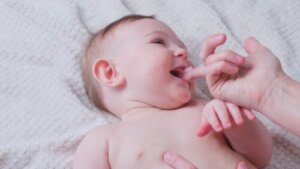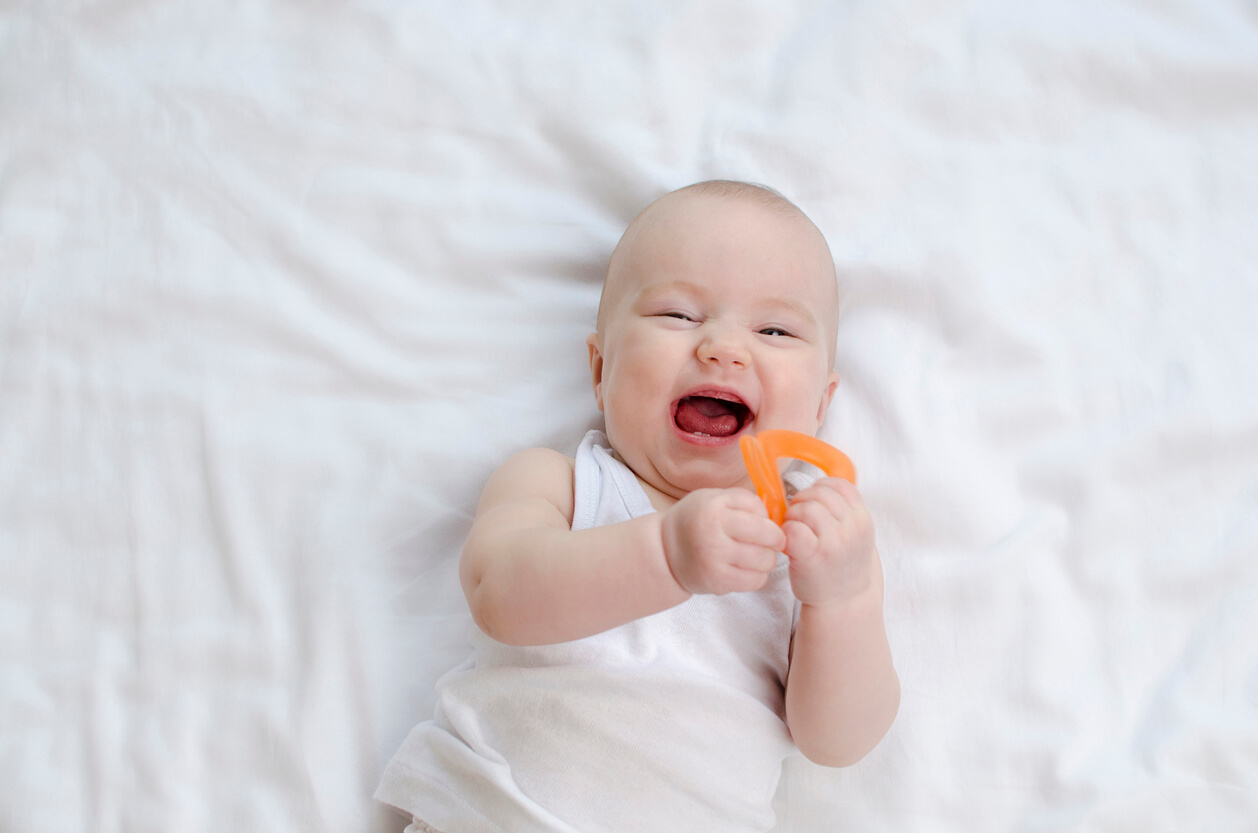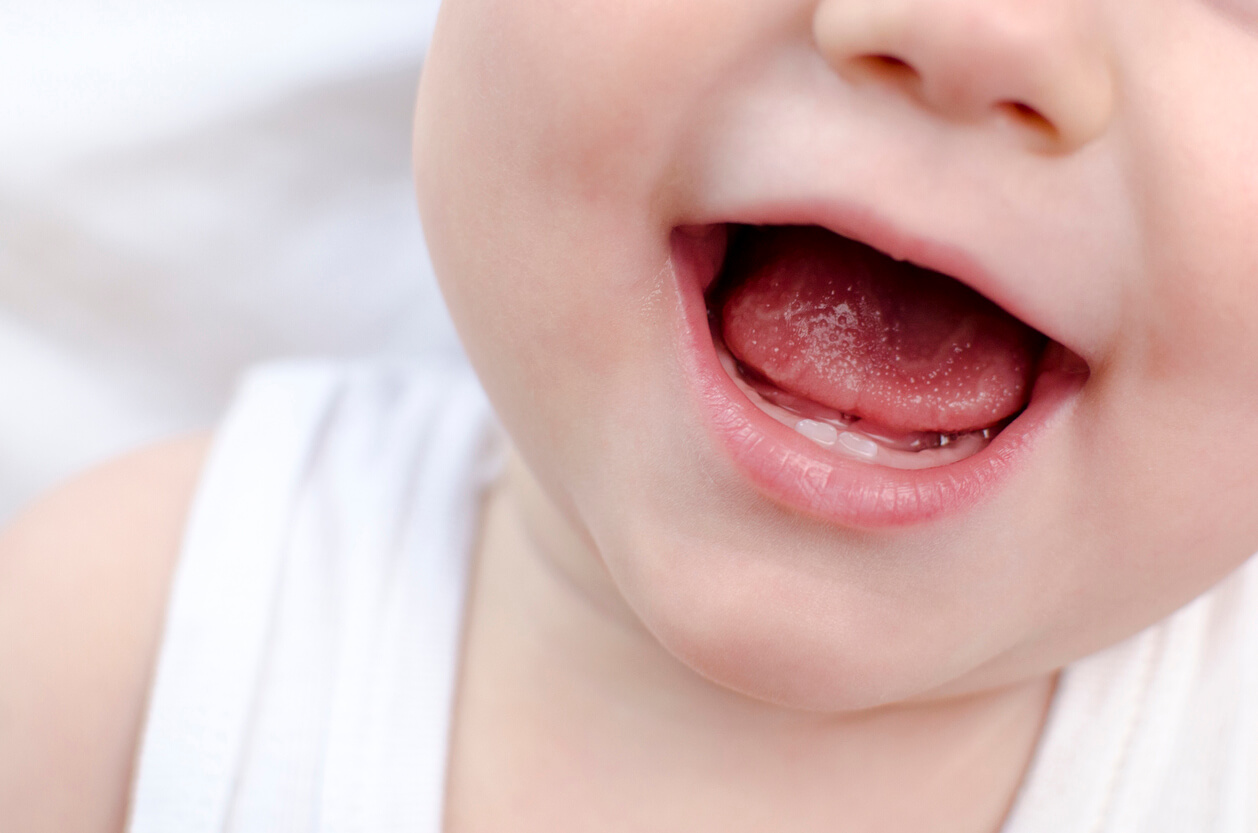Some Newborns Have Teeth When They're Born


Written and verified by the dentist Vanesa Evangelina Buffa
Most babies usually get their first teeth around six months of age. However, some newborns have teeth when they come into the world. You may be worried and concerned about this situation, so here’s everything you need to know and how to take care of your little one’s oral health.
All children are born with their tooth buds inside their bones. It’s after several months that the first elements begin to emerge through the gums and the eruption process begins. However, some babies are born with teeth that have already erupted, or they emerge within a few days of birth. This is a situation that occurs in 1 in 3000 births.
Why do some newborns have teeth?
A baby’s teeth begin to form in the mother’s womb during gestation. Throughout pregnancy and after birth, the teeth continue to develop. In general, around the sixth or eighth month of life, the first teeth appear.
The process continues progressively until the eruption of the 20 milk teeth is complete, which occurs around the child’s third birthday. However, you should know that the age of eruption of each tooth is an estimate and depends on the growth rate of each child.
Natal and neonatal teeth
As we’ve seen, some newborns may have teeth at birth or in their first days of life. It’s believed that this is because the developing tooth germ has a very superficial positioning and breaks through the gum much earlier than expected. These can be either natal or neonatal teeth:
- Natal: These are teeth that are present at birth.
- Neonatal: Those that erupt in the first 30 days of life.

Possible causes for the appearance of teeth in newborns
The causes for the appearance of these teeth earlier than usual aren’t entirely clear. However, it’s believed that it could be due to one of the following reasons:
- Hereditary factors
- Nutritional deficiencies
- Lack of vitamins from the mother
- Fever or other disorders
Types of teeth in newborns
When newborns have teeth in the mouth, the scenario isn’t always very clear. Different situations may arise that need to be considered:
- The tooth may be fixed or it may be mobile and loose.
- The element may have no roots at all or have some root structure.
- The tooth may be part of the deciduous dentition or be a supernumerary element.
In most cases, a single tooth is usually present in the lower front area. Being born with several elements is quite unusual. Also, it’s more common for babies to have natal elements. Most of the time, these are primary teeth that appear early and, less frequently, are supernumerary elements.
Complications of natal and neonatal teeth
The presence of teeth in a newborn is a situation that should be evaluated by a healthcare team to avoid mishaps. Although in most cases, it’s not a problem, there are some possible complications that should be considered:
- Risk of aspiration: Some natal and neonatal teeth don’t have sufficient root development and therefore move. Consequently, the tooth can become detached and be aspirated by the baby. In these cases, extraction of the element may be considered.
- Mucosal injuries: The edges and tips of the newborn’s teeth can injure, irritate, and ulcerate the tongue and lips of the little one. Injuries to the ventral surface of the tongue caused by the trauma of natal teeth in the lower jaw are known as Riga-Fede’s ulcers.
- Problems during feeding: When the baby’s teeth injure the little one’s tongue during sucking at the mother’s breast, this can cause rejection of breastfeeding and even other types of feeding.
- Changes in dental appearance: Because they’re premature teeth, they may not have the usual appearance of teeth and have immature tissues.

Caring for newborns with teeth
When newborns have teeth, it’s important for a health team to assess their situation. If natal or neonatal teeth don’t cause any problems for the child or the mother, experts recommended keeping them in the mouth. As time goes by, they tend to lose mobility and manage to remain as normal temporary teeth.
Hygienize newborn teeth
In addition, it’s important to take into account that, due to the lower degree of development of dental tissues, these teeth are at greater risk of disease. For this reason, it’s important to keep them clean from the beginning, cleaning them with a small soft brush or moistened gauze.
Check your baby’s tongue
It’s also important to examine and check your baby’s tongue and gums on a regular basis to make sure that the teeth aren’t causing any injury. If wounds appear on the tongue or other mucous membranes, they should be treated with an antiseptic and their evolution should be monitored.
A pediatric dentist may suggest polishing the edges of the teeth to reduce trauma. Another option to consider is the use of a mouthpiece that keeps the element immobile and prevents injuries. In addition, if the mobility or discomfort is very severe or prevents the child from feeding, the pediatric dentist may indicate the extraction of the tooth. This is a simple procedure that’s performed under local anesthesia and with the baby in the arms of its mother or caregiver.
In conclusion…
Although it’s not the most common of cases, some newborns can be born with teeth. If your baby comes into the world with any teeth in the mouth, you should seek the advice and support of a pediatric dentist. With a health team to support you, the teeth in the mouth of your newborn baby won’t be a problem.
Most babies usually get their first teeth around six months of age. However, some newborns have teeth when they come into the world. You may be worried and concerned about this situation, so here’s everything you need to know and how to take care of your little one’s oral health.
All children are born with their tooth buds inside their bones. It’s after several months that the first elements begin to emerge through the gums and the eruption process begins. However, some babies are born with teeth that have already erupted, or they emerge within a few days of birth. This is a situation that occurs in 1 in 3000 births.
Why do some newborns have teeth?
A baby’s teeth begin to form in the mother’s womb during gestation. Throughout pregnancy and after birth, the teeth continue to develop. In general, around the sixth or eighth month of life, the first teeth appear.
The process continues progressively until the eruption of the 20 milk teeth is complete, which occurs around the child’s third birthday. However, you should know that the age of eruption of each tooth is an estimate and depends on the growth rate of each child.
Natal and neonatal teeth
As we’ve seen, some newborns may have teeth at birth or in their first days of life. It’s believed that this is because the developing tooth germ has a very superficial positioning and breaks through the gum much earlier than expected. These can be either natal or neonatal teeth:
- Natal: These are teeth that are present at birth.
- Neonatal: Those that erupt in the first 30 days of life.

Possible causes for the appearance of teeth in newborns
The causes for the appearance of these teeth earlier than usual aren’t entirely clear. However, it’s believed that it could be due to one of the following reasons:
- Hereditary factors
- Nutritional deficiencies
- Lack of vitamins from the mother
- Fever or other disorders
Types of teeth in newborns
When newborns have teeth in the mouth, the scenario isn’t always very clear. Different situations may arise that need to be considered:
- The tooth may be fixed or it may be mobile and loose.
- The element may have no roots at all or have some root structure.
- The tooth may be part of the deciduous dentition or be a supernumerary element.
In most cases, a single tooth is usually present in the lower front area. Being born with several elements is quite unusual. Also, it’s more common for babies to have natal elements. Most of the time, these are primary teeth that appear early and, less frequently, are supernumerary elements.
Complications of natal and neonatal teeth
The presence of teeth in a newborn is a situation that should be evaluated by a healthcare team to avoid mishaps. Although in most cases, it’s not a problem, there are some possible complications that should be considered:
- Risk of aspiration: Some natal and neonatal teeth don’t have sufficient root development and therefore move. Consequently, the tooth can become detached and be aspirated by the baby. In these cases, extraction of the element may be considered.
- Mucosal injuries: The edges and tips of the newborn’s teeth can injure, irritate, and ulcerate the tongue and lips of the little one. Injuries to the ventral surface of the tongue caused by the trauma of natal teeth in the lower jaw are known as Riga-Fede’s ulcers.
- Problems during feeding: When the baby’s teeth injure the little one’s tongue during sucking at the mother’s breast, this can cause rejection of breastfeeding and even other types of feeding.
- Changes in dental appearance: Because they’re premature teeth, they may not have the usual appearance of teeth and have immature tissues.

Caring for newborns with teeth
When newborns have teeth, it’s important for a health team to assess their situation. If natal or neonatal teeth don’t cause any problems for the child or the mother, experts recommended keeping them in the mouth. As time goes by, they tend to lose mobility and manage to remain as normal temporary teeth.
Hygienize newborn teeth
In addition, it’s important to take into account that, due to the lower degree of development of dental tissues, these teeth are at greater risk of disease. For this reason, it’s important to keep them clean from the beginning, cleaning them with a small soft brush or moistened gauze.
Check your baby’s tongue
It’s also important to examine and check your baby’s tongue and gums on a regular basis to make sure that the teeth aren’t causing any injury. If wounds appear on the tongue or other mucous membranes, they should be treated with an antiseptic and their evolution should be monitored.
A pediatric dentist may suggest polishing the edges of the teeth to reduce trauma. Another option to consider is the use of a mouthpiece that keeps the element immobile and prevents injuries. In addition, if the mobility or discomfort is very severe or prevents the child from feeding, the pediatric dentist may indicate the extraction of the tooth. This is a simple procedure that’s performed under local anesthesia and with the baby in the arms of its mother or caregiver.
In conclusion…
Although it’s not the most common of cases, some newborns can be born with teeth. If your baby comes into the world with any teeth in the mouth, you should seek the advice and support of a pediatric dentist. With a health team to support you, the teeth in the mouth of your newborn baby won’t be a problem.
All cited sources were thoroughly reviewed by our team to ensure their quality, reliability, currency, and validity. The bibliography of this article was considered reliable and of academic or scientific accuracy.
- Umayal, S., Gounder, R., & Ganapathy, D. (2019). Neonatal teeth and its causes-A review. Drug Invention Today, 11(2).
- Samuel, S. S., Ross, B. J., Rebekah, G., & Koshy, S. (2018). Natal and neonatal teeth: a tertiary care experience. Contemporary clinical dentistry, 9(2), 218.
- Bulut, G., Bulut, H., & Ortac, R. (2019). A comprehensive survey of natal and neonatal teeth in newborns. Nigerian journal of clinical practice, 22(11), 1489-1489.
- Shivpuri, A., Mitra, R., Saxena, V., & Shivpuri, A. (2021). Natal and neonatal teeth: Clinically relevant findings in a retrospective analysis. medical journal armed forces india, 77(2), 154-157.
- DeSeta, M., Holden, E., Siddik, D., & Bhujel, N. (2022). Natal and neonatal teeth: a review and case series. British Dental Journal, 232(7), 449-453.
- Martínez-Gómez, V. (1997). Dientes natales y neonatales: revisión de la literatura: primera parte. Acta odontol. venez, 54-60.
- Biart, B. A., Martín, B. R., Prado, M. A. L., Alfonso, K. I. G., Ramos, S. L. R., & González, M. H. (2021). Dientes neonatales. Investigaciones Medicoquirúrgicas, 13(1).
- Moreno, C. G., & Argueta, G. G. (2022, October). Tratamiento de la úlcera de Riga Fede. In XXI Congreso Latinoamericano de Odontopediatría (Vol. 12, No. Suplemento).
This text is provided for informational purposes only and does not replace consultation with a professional. If in doubt, consult your specialist.








